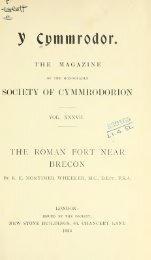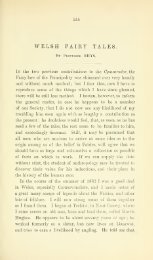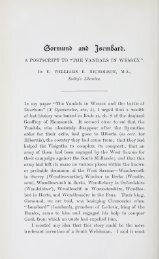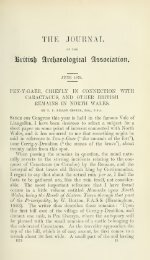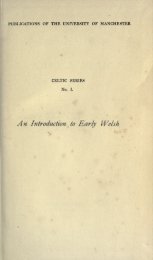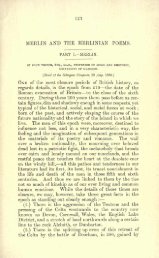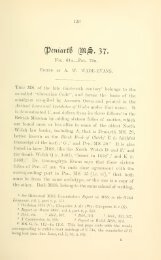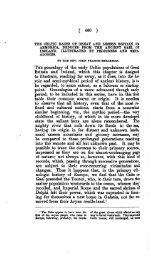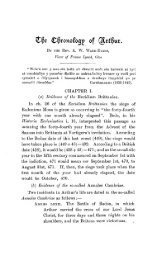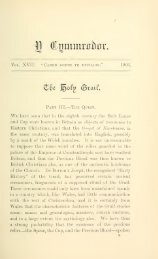Vandals in Wessex (Battle of Deorham) - Kingarthur.justwizard.com
Vandals in Wessex (Battle of Deorham) - Kingarthur.justwizard.com
Vandals in Wessex (Battle of Deorham) - Kingarthur.justwizard.com
Create successful ePaper yourself
Turn your PDF publications into a flip-book with our unique Google optimized e-Paper software.
£0e (üanbafa ín Ititeetp anò tÿt<br />
(gatttt <strong>of</strong> ©eorflam.<br />
By e. willtams b. NICHOLSON, M.A.,<br />
Bodley's Librarian.<br />
In 577 CuSw<strong>in</strong>e (or Cujw<strong>in</strong>e) and Ceawl<strong>in</strong> are said by<br />
Saxon chronicles to have fought the Britons at <strong>Deorham</strong><br />
(now Dyrham, <strong>in</strong> Grloucestershire) ;<br />
to have sla<strong>in</strong> three<br />
k<strong>in</strong>gs — Conmsegl, Condidan, and Far<strong>in</strong><strong>in</strong>segl ;<br />
and to have<br />
taken three chesters— Gleawan ceaster, Cirenceaster, and<br />
Bathan ceaster. This victory was most momentous, for<br />
the capture <strong>of</strong> Gloucester, Cirencester, and Bath separated<br />
Somerset, Devon, and Cornwall from Wales.<br />
Of the provenance <strong>of</strong> these k<strong>in</strong>gs Freeman says noth<strong>in</strong>g;<br />
Guest and Green <strong>in</strong>fer that they were the k<strong>in</strong>gs <strong>of</strong> the<br />
three cities, and the former th<strong>in</strong>ks that Cí <strong>in</strong> all Hkelihood"<br />
Conmsegl ruled Gloucester ; I presume<br />
he would have<br />
given Cirencester to Condidan, and Bath to Far<strong>in</strong>msegl.<br />
Sharon Turner and Villemarqué, Guest tells us, identify<br />
Condidan with "the Kyndylan whose death is bewailed <strong>in</strong><br />
an old Welsh manonad, or elegy. But it appears clearly<br />
enough from the elegy that Kyndylan was sla<strong>in</strong> near<br />
Shrewsbury, and, therefore, could not possibly be the<br />
Condidan who, accord<strong>in</strong>g to the chronicle, was sla<strong>in</strong> at<br />
<strong>Deorham</strong>, <strong>in</strong> Gloucestershire". Mr. Plummer identifies the<br />
two without remark, add<strong>in</strong>g that "noth<strong>in</strong>g seems to be<br />
known <strong>of</strong> the other two Welsh pr<strong>in</strong>ces".
6 The <strong>Vandals</strong> <strong>in</strong> <strong>Wessex</strong><br />
If we want to get at the entire truth about these early<br />
campaigns we uiust not, as has been the unscientific<br />
fashion, totally ignore Ge<strong>of</strong>frey <strong>of</strong> Mon<strong>in</strong>outh. 1 He tells<br />
us (xi, 8) that the head <strong>of</strong> the British k<strong>in</strong>gs<br />
at this time<br />
was Karetic, a lover <strong>of</strong> civil war, hateful to God and his<br />
own people. That the Saxons f<strong>in</strong>d<strong>in</strong>g out his <strong>in</strong>stability<br />
<strong>in</strong><br />
1<br />
See my letters, "Mons Badonicus and Ge<strong>of</strong>frey <strong>of</strong> Monmouth",<br />
The Academy for Mar. 14 and Apr. 11, 1896; no attempt has ever<br />
been made to answer them. Let me add the follow<strong>in</strong>g additional<br />
remarks. Ge<strong>of</strong>írey certa<strong>in</strong>ly wrote the rubbish <strong>in</strong> Book VII (the prophecies<br />
<strong>of</strong> Merl<strong>in</strong>) about the "serpens Malvernie", "Totonesius aper",<br />
"L<strong>in</strong>docol<strong>in</strong>us coluber", etc, which he meant to be applied by his<br />
readers to the troubles then go<strong>in</strong>g on. But the Breton element is<br />
very manifest <strong>in</strong> the follow<strong>in</strong>g <strong>in</strong>cidents :— (1) Brutus, before settl<strong>in</strong>g<br />
<strong>in</strong> Brita<strong>in</strong>, lands at the mouth <strong>of</strong> the Loire, defeats the Pictavians,<br />
and founds the city <strong>of</strong> Tours (the future ecclesiastical metropolis <strong>of</strong><br />
— the Bretons) i, 12, etc. (2) Maximian creates a British k<strong>in</strong>gdom <strong>in</strong><br />
Armorica under Conan Meriadoc— v, 12. (3) Hengist, <strong>in</strong> his f<strong>in</strong>al<br />
and fatal —<br />
battle, is defeated only by a cavalry-charge <strong>of</strong> Bretons<br />
viii, 5. (4) Arthur retreats from York to London before heavy Saxon<br />
re<strong>in</strong>forcements, but on be<strong>in</strong>g jo<strong>in</strong>ed by his nephew Hoel, k<strong>in</strong>g <strong>of</strong><br />
Brittany, with 15,000 Bretons, drives the Saxons to the neighbourhood<br />
<strong>of</strong> the Forth— ix, 2, etc. (5) Arthur conquers the Romans <strong>in</strong><br />
Gaul— x. (6) Cadwallon ílies to Salomon, k<strong>in</strong>g <strong>of</strong> Brittany. returns<br />
with 10,000 Bretons, and makes havoc <strong>of</strong> the Saxons— xii, 4, etc.<br />
(7) Cadwallader flees with his people, — devastated by fam<strong>in</strong>e and<br />
plague, to Alan, k<strong>in</strong>g <strong>of</strong> Brittany xii, 15. The Bretons were so<br />
largely derived from Cornwall and Devon that two <strong>of</strong> their four prov<strong>in</strong>ces<br />
were named Cornubia and Domnonia, and (8) Cor<strong>in</strong>eus, the<br />
eponymous hero <strong>of</strong> Cornwall, is Brutus's second <strong>in</strong> <strong>com</strong>mand, kills<br />
Tyrrhenian giants by threes and fours, and chooses Cornwall for his<br />
portíon <strong>of</strong> Brita<strong>in</strong> on account <strong>of</strong> its greater fertility <strong>in</strong> giants !— i, 12,<br />
16 ;<br />
while (9j <strong>in</strong> the Roman and post-Roman times the dux Üornubie,<br />
or rex Cornubie, constantly figures as the most prom<strong>in</strong>ent person next<br />
to the imperator.<br />
Part only <strong>of</strong> the first two <strong>in</strong>cidents had been given<br />
by Nennius, and tliat all the rest should be the mere <strong>in</strong>vention <strong>of</strong> ;i<br />
Soutli Welshman (whom we do not know to liave ever set foot <strong>in</strong><br />
Brittany or Cornwall) would be strange <strong>in</strong> any case. And <strong>in</strong> face<br />
<strong>of</strong> hís statement that he had tranalated a Breton book brought him<br />
by the Archdeacon f Oxford (still alive to deny<br />
the statement if<br />
untrue) it seems to me to exceed the bounds <strong>of</strong> reasonable theoriz<strong>in</strong>g.
and the <strong>Battle</strong> <strong>of</strong> <strong>Deorham</strong>. 7<br />
went to Goduiund, Gotmund, Goruiund, or Gurmund<br />
1<br />
k<strong>in</strong>g<br />
<strong>of</strong> the Africans (<strong>Vandals</strong> ?) <strong>in</strong>to Hibernia (? Hiberia, i.e.<br />
Spa<strong>in</strong>) "<strong>in</strong> quam maximis nayigiis advectus gentem patrise<br />
subiuo;averat". That the African landed with 166,000<br />
men, attacked Karetic, after very many battles chased<br />
him from city to city, at last blockaded him <strong>in</strong> Cirencester,<br />
captured and burnt the city, beat Karetic aga<strong>in</strong>,<br />
and drove him beyond the Severn. And that, while he<br />
was besieg<strong>in</strong>g Cirencester, Isembard, grandson <strong>of</strong><br />
Lodovic<br />
k<strong>in</strong>g <strong>of</strong> the Franks, carne to hi<strong>in</strong> and entered <strong>in</strong>to a treaty<br />
with him, by which he forsook his Christianity for the purpose<br />
<strong>of</strong> obta<strong>in</strong><strong>in</strong>g help to w<strong>in</strong> the k<strong>in</strong>gdom <strong>of</strong> Gaul from<br />
his uncle, by whom he said he had been unjustly expelled.<br />
Now, if the whole <strong>of</strong> this story about the Africans were<br />
utter nonsense,<br />
South Welshman <strong>of</strong> the twelfth<br />
it would still not be the nonsense that a<br />
century would <strong>in</strong>vent <strong>in</strong><br />
writ<strong>in</strong>g a history <strong>of</strong> Brita<strong>in</strong>, and, as <strong>in</strong> other parts<br />
<strong>of</strong> his<br />
the battle <strong>of</strong> <strong>Deorham</strong> was fought.<br />
work, Breton tradition is obvious. Chlodowig (Clovis), k<strong>in</strong>g<br />
<strong>of</strong> the Franks (who, <strong>of</strong> course, were neighbours to the<br />
Bretons), died <strong>in</strong> 511, and his grandsons were alive when<br />
Tn 558 his son Childebert,<br />
k<strong>in</strong>g <strong>of</strong> Paris, died, and the widow and two daughters<br />
were exiled by Childebert's younger brother Chlothachar.<br />
The widow may have given birth to a posthumous son,<br />
or a pretender may have claimed to be her son. Or,<br />
Isenbard may have claimed to be the great-grandson<br />
<strong>of</strong> Chlodowig, posthumous<br />
child <strong>of</strong> one <strong>of</strong> the wives <strong>of</strong><br />
1 The uncritical pr<strong>in</strong>ted texts before me read Gor-. The Bern<br />
MS. (Stadtbibliothek, 568) has Got-, but <strong>in</strong> 1898 I found from the<br />
make-up <strong>of</strong> the volume that, <strong>in</strong> spite <strong>of</strong> its<br />
Stephen-dedication, it was<br />
not copied before the end <strong>of</strong> 1170. The Welsh version also has Got-.<br />
The Bodleian MSS. vary. MS. Bodl. 014 (12th cent.) and four others<br />
have God-. The important twelfth cent. MS. Rawl<strong>in</strong>son C. Iö2 is<br />
very careless at this po<strong>in</strong>t and has the remarkable read<strong>in</strong>g Grund<strong>of</strong>orû.
8 The <strong>Vandals</strong> <strong>in</strong> <strong>Wessex</strong><br />
Charibert, k<strong>in</strong>g <strong>of</strong> Paris, who died <strong>in</strong> 567, and whose<br />
k<strong>in</strong>gdom was then taken by his younger brother Chilperic.<br />
Isenbard would be an excellent Franldsh name, and the<br />
promise to renounce his Christianity is expla<strong>in</strong>ed by the<br />
fact that the <strong>Vandals</strong> were Arians. It is vastly more<br />
probable that his story has a kernel <strong>of</strong> fact than that it is<br />
an irrelevant and purposeless fable.<br />
And now for the <strong>Vandals</strong>. In 533 their African k<strong>in</strong>gdom<br />
was destroyed ;<br />
some were sent to Constant<strong>in</strong>ople to<br />
be drafted <strong>in</strong>to the imperial army, and the rest were to be<br />
expatriated (Procopius, de bell. Vand., ii, 19). Where<br />
were they to go ? Why not to Spa<strong>in</strong>, 1 the country from<br />
which they had <strong>com</strong>e, and <strong>of</strong> which the rul<strong>in</strong>g race were<br />
Teutons like themselves? It would be equally natural<br />
that their<br />
males should take service as mercenaries under<br />
the Visigoths, who were then gradually <strong>com</strong>plet<strong>in</strong>g the<br />
conquest <strong>of</strong> the Pen<strong>in</strong>sula.<br />
It would, <strong>of</strong> course, be conceivable that they should<br />
migrate to Ireland, but <strong>in</strong> Irish chronicles I cannot fìnd<br />
any trace <strong>of</strong> an <strong>in</strong>vasion at this time. And <strong>in</strong> favour <strong>of</strong><br />
my emendation Hiberiam it is important to add that the<br />
" Lucius Tiberius" <strong>of</strong> our pr<strong>in</strong>ted texts <strong>of</strong> Ge<strong>of</strong>frey should<br />
be Lucius Hiberus (the Iberian), accord<strong>in</strong>g to the weight<br />
<strong>of</strong> the MS. authority known to me. I strongly suspect<br />
romance <strong>of</strong> Arthur's war with<br />
that beneath the fantastic<br />
him there lies the memory <strong>of</strong> a struggle between the<br />
Bretons and some Aquitanian Visigoth, who claimed to<br />
represent Eoman authority, and aga<strong>in</strong>st whom Arthur<br />
may have helped them as they had helped Arthur aga<strong>in</strong>st<br />
the Saxons and Picts.<br />
Vortigern is said to have <strong>in</strong>vited the foreign-speak<strong>in</strong>g<br />
1<br />
The eighth cent. Ravenna geographer says the race fled to<br />
Manritania Gaditana (iii, lá) and disappeared ("nusquam <strong>com</strong>paruit").<br />
Mauritania Gaditana is the coast nuarest Spa<strong>in</strong>.
and the <strong>Battle</strong> <strong>of</strong> <strong>Deorham</strong>. 9<br />
Saxons to aicl him <strong>in</strong> fìght<strong>in</strong>g the Picts ancl Scots ;<br />
it<br />
would be more natural that the Saxons themselves<br />
shoulcl<br />
<strong>in</strong>vite the aicl <strong>of</strong> Vandal mercenaries, who spoke a tongue<br />
virtually identical with their own. Dr.<br />
Guest, <strong>in</strong> his paper<br />
011 "The English conquest <strong>of</strong> the Severn valley" (Ârch.<br />
Gamb., III, ix, 134), has said "there is reason to believe<br />
that about the year 571 the k<strong>in</strong>gs <strong>of</strong> <strong>Wessex</strong> received an<br />
accession <strong>of</strong> strength, that enabled them to carry war <strong>in</strong>to<br />
the very heart <strong>of</strong> the Welsh territory". He adds, "I do<br />
not stop to <strong>in</strong>quire whence came this <strong>in</strong>crease <strong>of</strong> strength".<br />
That it came from Vandal mercenaries 1 propose<br />
to establish<br />
by an appeal to Old English place-names.<br />
In Anglo-Saxon we <strong>in</strong>eet with the name <strong>of</strong> a people<br />
Wend(e)las, <strong>of</strong> which the genitive Wendla and dative<br />
Wendlum occur.<br />
The Bosworth-Toller dictionary queries<br />
it as either the people <strong>of</strong> Vendil (North Jutland) or the<br />
<strong>Vandals</strong>. We also have Wendelssé as the A.S. name <strong>of</strong><br />
the Mediterranean, presumably given<br />
to it froni the <strong>Vandals</strong>,<br />
who occupied<br />
fìrst Andalusia (=Vandalusia ?),<br />
then<br />
North Africa, the Balearic isles, and Sard<strong>in</strong>ia. Consecjuently,<br />
we may presume<br />
that the name "Vandal" <strong>in</strong> Old<br />
English place-names would appear as Wendel-, Wendl-, or<br />
Wenl-. And we f<strong>in</strong>d that stem <strong>in</strong> the follow<strong>in</strong>g names :—<br />
In Surrey, Wendlesuurthe, now Wandsworth.<br />
In Berhshire, Wendlesore, W<strong>in</strong>dlesore, now W<strong>in</strong>dsor.<br />
Wamdlescumb.<br />
In Oceýordshire, Wendelebur', now Wendlebury.<br />
In Worcestershire, Wendlesclif .<br />
In Hertfordshire, Wendlesbiri.<br />
On the borders <strong>of</strong> Hunt<strong>in</strong>gdonshire and Cambridgeshire,<br />
Wenlesmere, or Wendlesmére.<br />
These are all the <strong>in</strong>stances I can tìncl. The tìrst five are<br />
certa<strong>in</strong>ly with<strong>in</strong> Ceawl<strong>in</strong>s's <strong>Wessex</strong>, and the renia<strong>in</strong><strong>in</strong>g<br />
two maij have been.
io The <strong>Vandals</strong> <strong>in</strong> <strong>Wessex</strong><br />
It<br />
has been suggested that such places niay have been<br />
stations <strong>of</strong> Vandal troops under the late Eoman empire.<br />
But the Gorpus Inscriptionum Lat<strong>in</strong>arum exhibits no<br />
evidence that the Ro<strong>in</strong>ans ever brought <strong>Vandals</strong> <strong>in</strong>to<br />
Brita<strong>in</strong>, and I must consider the distribution <strong>of</strong> the names<br />
as argu<strong>in</strong>g the essential truth <strong>of</strong> Ge<strong>of</strong>frey's tradition. It<br />
is not unimportant to add that Wencllebury <strong>in</strong> Oxfordshire<br />
is the last station before Cirencester on one <strong>of</strong> the Roman<br />
roads, and has an old Boman camp which the <strong>Vandals</strong> doubtless<br />
occupied, perhaps after first driv<strong>in</strong>g Earetic out <strong>of</strong> it.<br />
Let me also call attention to two places apparently<br />
named after the Vandal leader Godmund, for <strong>in</strong> Anglo-<br />
Saxon that name is only found twice, and not before the<br />
eleventh century.<br />
The first <strong>of</strong> these is<br />
Godmundcestre, now Godmanchester.<br />
It is less than twenty miles N.W. <strong>of</strong> Bedcanford,<br />
Bedford, where Ceawl<strong>in</strong>'s lc<strong>in</strong>sman Cuthwulf fouo-ht the<br />
Britons <strong>in</strong> 571, and is the Boma<strong>in</strong> Durolipons (Duroli<br />
Pons ?), doubtless possess<strong>in</strong>g castra which Godmund occupied.<br />
The second is<br />
Godrnundesleah, Godmund's Lea, the<br />
place at which a charter <strong>of</strong> 779 (Birch, Cartularium, no. 230)<br />
was signed. Its situation is unknown, but the land to<br />
which it relates lies on the ancient Fosse road, about fifteen<br />
miles N.W. <strong>of</strong> Cirencester, at Bourton-on-the-Water. I<br />
suspect that the name <strong>com</strong>memorates a battle fought by<br />
Godmund, and the fact that one <strong>of</strong> the boundaries is<br />
"slohtran ford "— represented by Upper Slaughter and<br />
Lower Slaughter<br />
— confirms this suspicion, though I<br />
that M.E. slaghter has not been traced <strong>in</strong> Anglo-Saxon.<br />
know<br />
Remarkable, also, is the name <strong>of</strong> a place,<br />
close to<br />
Bourton, mentioned <strong>in</strong> the same charter— "urbi illi qui<br />
nom<strong>in</strong>atur sulmonnes burg".<br />
Now, there is no Anglo-Saxon name at all like Sulmonn
and thc Battlc <strong>of</strong> <strong>Deorham</strong>. 1 1<br />
fco be found <strong>in</strong> Searle's Onomasticon earlier thau Domesday<br />
Bonl\ <strong>in</strong> which we eet the nauie Salouion aud a Salmonesberie<br />
<strong>in</strong> Sussex.<br />
The Fosse road "passes with<strong>in</strong> a few furlongs from the<br />
Yillage ;<br />
and at about the sauie Dìstance froru the Road is<br />
a Cauip <strong>of</strong> a quadrangular Form, <strong>in</strong>elos<strong>in</strong>g Sixty Aeres,<br />
proved to have been a Eomau Statiou. by the discovery <strong>of</strong><br />
<strong>in</strong>s and other Yestiges. On this Spot a Court Leet for<br />
the Hundred <strong>of</strong> Salemansbury, now <strong>of</strong> Slaughter, is annually<br />
It is doubtless from<br />
held*' (Bigland, Co. <strong>of</strong> Gloucester, 22Ò .<br />
this eneaiupuient that Bourton (=Burh-tán) takes its name.<br />
That there were similar names <strong>in</strong> Old German can<br />
be seen iu Förstemann— so that the abseuce <strong>of</strong> evideuce<br />
for it <strong>in</strong> Anglo-Saxon before Domesday<br />
is not decisive<br />
açra<strong>in</strong>st its hav<strong>in</strong>g been an Anfflo-Saxon name before<br />
779. But Salo<strong>in</strong>on was an uudoubted Breton name,<br />
borne by a Breton k<strong>in</strong>g iu 857-74. and, if we may<br />
belieye Ge<strong>of</strong>frey's tradition, by an earlier Breton k<strong>in</strong>g<br />
<strong>of</strong> the seventh ceutury. And, I suspect that ; just as<br />
Arthur had (accord<strong>in</strong>g to Ge<strong>of</strong>frey) obta<strong>in</strong>ed the help<br />
<strong>of</strong> a Breton foree aga<strong>in</strong>st the Saxons, so had Earetic ;<br />
that its leader was uamed Salomou ; that he had occu-<br />
1 I snspect Salemansbury to be the Kaer Seleraeion <strong>of</strong> the Triads<br />
iu the Beâ BooJc <strong>of</strong> Hergest. In the pr<strong>in</strong>ted text <strong>of</strong> Nennius this is<br />
Gair Celemion. with various readìngs, elimon, eilimon. celemon. eelimon.<br />
celimeno, celeimon. ceiìimon. Pr<strong>of</strong>. Rhys tells me that Solomon is Selyf<br />
<strong>in</strong> Welsh, but <strong>in</strong> the Booìc <strong>of</strong> Llan Dáv I íìnd also Selim, and eren<br />
Salomon :<br />
probably Nennius wrote Selimon. The vv.ll. be_çnnn<strong>in</strong>g eleilsuggest<br />
that all the exist<strong>in</strong>g read<strong>in</strong>gs spr<strong>in</strong>g from a MS. <strong>in</strong><br />
which the ülum<strong>in</strong>ator omitted to íill <strong>in</strong> the S. and that some copyists<br />
wrongly supplied its place with a C. Compare the genealogies o£ the<br />
líarleian 1£S 3839, where [Sjelim is written without the S. at top <strong>of</strong><br />
uos. xxíi. xsiv. Thosegeneal ° sxvii) mention a Selemiaun. father<br />
1<br />
1 2 The <strong>Vandals</strong> <strong>in</strong> <strong>Wessex</strong><br />
pied the old Roman camp ;<br />
that with him had conie<br />
over the Frankish refugee Isenbard ;<br />
that thej had<br />
<strong>com</strong>b<strong>in</strong>ed <strong>in</strong> an attempt to draw <strong>of</strong>f Godmund to France ;<br />
but that Tsenbard shocked the Bretons by <strong>of</strong>fer<strong>in</strong>g to<br />
be<strong>com</strong>e Arian. That would expla<strong>in</strong> very si<strong>in</strong>ply how this<br />
unique <strong>in</strong>formation got<br />
is at the bottom <strong>of</strong> Ge<strong>of</strong>frey's book.<br />
<strong>in</strong>to the Breton tradition which<br />
The supposed number <strong>of</strong> the <strong>Vandals</strong> is, <strong>of</strong> course,<br />
absurd, but even that may conta<strong>in</strong> the germ<br />
<strong>of</strong> the truth.<br />
It may have been orig<strong>in</strong>ally written MCLXYI, i.e. 1166, and<br />
M may have been mis<strong>in</strong>terpreted as = millia. If anyone<br />
th<strong>in</strong>ks this too small a re<strong>in</strong>forcement to be effective, let me<br />
mention two facts. (1) Anglo-Saxon chronicles state that<br />
<strong>in</strong> the battle <strong>of</strong> 508 the British<br />
k<strong>in</strong>g had 5,000 with him,<br />
as if this were a very large number (<strong>com</strong>pared at least<br />
with the Saxon strength). (2) In 655 the South Mercians<br />
were only 5,000 families, and the North Mercian land<br />
supported only 7,000 families 1 (Bede, H.E., iii, 24)— a total<br />
for both k<strong>in</strong>gdoms which represents little more than the<br />
present population <strong>of</strong> Oxford.<br />
In such times the addition<br />
<strong>of</strong> 1166 tra<strong>in</strong>ed mercenaries, probably skilled <strong>in</strong> unfamiliar<br />
modes <strong>of</strong> fight<strong>in</strong>g which would confuse their opponents,<br />
would be a most important ga<strong>in</strong> to the West Saxons.<br />
The <strong>Vandals</strong> would naturally land from Southampton<br />
Water, and I suspect that they were imported as early as<br />
568, and that their fìrst settlement was at W<strong>in</strong>dsor. In<br />
that year <strong>Wessex</strong> defeated Kent at Wibban dun, suj)-<br />
posed to be Wimbledon, near the banks <strong>of</strong> the Thames;<br />
and Wendlesuurthe, now Wandsworth, is on the riverbank<br />
only two or three miles distant. I am aware that<br />
Wandsworth is on the Wandle, but no other stream seems<br />
to bear that name, and I suspect that its Saxon style<br />
T rlo not kno\v if Britons are <strong>in</strong>cluded, whether as <strong>in</strong>dependent<br />
faniilies or as serfs attached to English families.
anci the <strong>Battle</strong> <strong>of</strong> <strong>Deorham</strong>. 1 3<br />
(which has not <strong>com</strong>e down to us) nieant "the Vandal<br />
stream", i.e., the streani on which the <strong>Vandals</strong>had settled.<br />
In 571, Cuthwulf fought the Britons at Bedford. It<br />
would doubtless be from the events <strong>of</strong> this expedition that<br />
Wendlesbiri <strong>in</strong> Hertfordshire, Godmundcestre <strong>in</strong> Hunt<strong>in</strong>gdonshire,<br />
and Wendlesmere 1<br />
on the borders <strong>of</strong> Hunt<strong>in</strong>gdonshire<br />
and Cambridgeshire, got their names.<br />
In the same year Cuthwulf struck West, and captured<br />
Bens<strong>in</strong>gton and Eyusham <strong>in</strong> Oxfordshire, and it<br />
may have been then that Waendlescu<strong>in</strong>b was occupied by<br />
the <strong>Vandals</strong>. It lay just opposite Oxford, <strong>in</strong> the Boar's<br />
Hill neighbourhood.<br />
Wendlebury <strong>in</strong> Oxfordshire was probably occupied <strong>in</strong><br />
577, <strong>in</strong> the march on Cirencester, and Wendlesclif <strong>in</strong><br />
Woreestershire either <strong>in</strong> the same year (after the capture<br />
<strong>of</strong> Gloucester), or a later year, perhaps 584, when Ceawl<strong>in</strong><br />
apparently advanced North to Faddiley <strong>in</strong> Cheshire.<br />
The question rema<strong>in</strong>s what became <strong>of</strong> these <strong>Vandals</strong> ?<br />
Ge<strong>of</strong>frey's text applies to them (xi, 8) words used by Gildas<br />
(24) <strong>of</strong> much earlier <strong>in</strong>vaders, and, later on (xi, 10),<br />
represents Godmund as wast<strong>in</strong>g nearly the entire isle, and<br />
giv<strong>in</strong>g the greater part <strong>of</strong> it, called Loegria (L\l~]oegr is<br />
Welsh for England), to the Saxons.<br />
My own suspicion is that the <strong>Vandals</strong> became <strong>in</strong>corporated<br />
with the Saxons. That they left descendants <strong>in</strong><br />
England seems to me morally certa<strong>in</strong>, if not from the name<br />
<strong>of</strong> Wendl<strong>in</strong>g <strong>in</strong> NorfoLk, at any rate from that <strong>of</strong> Wendl<strong>in</strong>gburh<br />
(now Well<strong>in</strong>gborough) <strong>in</strong> Northamptonshire.<br />
And the name <strong>of</strong> Godmundd<strong>in</strong>gaham, now Goodmanham,<br />
which is found as early as Bede (íT. E., ii, 13), suggests<br />
1 It is uncerta<strong>in</strong> whether this means yandal's boundary, or<br />
Vandal's lake : see the context <strong>in</strong> Kemble, Cod. Dipl., 904, with mére<br />
"boundary", and the map with various meres (e.ff., Whittlesey Mere)<br />
iiì the particular district.
14 The <strong>Vandals</strong> <strong>in</strong> <strong>Wessex</strong><br />
that even so far north as Yorbshire there was a family<br />
which claimed the Vandal leader as progenitor. 1<br />
Let me now deal with the names <strong>of</strong> the British k<strong>in</strong>gs<br />
said to have been killed at <strong>Deorham</strong>.<br />
Conmsegl ("Great Hound") I strongly suspect<br />
to have<br />
reigned <strong>in</strong> Merioneth. His name would be Cynfael <strong>in</strong><br />
modern Welsh. There is an Afon Gynfael, "Cynfael<br />
river", at Ffest<strong>in</strong>iog, doubtless so called because it flows<br />
past the two farms Cynfael Mawr, "Great Cynfael", and<br />
Cynfael Bach, "Little Cynfael". Doubtless, also, those<br />
farnis are called (more Celtico) because they belonged to a<br />
man named Cynfael. F<strong>in</strong>ally, some seven or eight miles<br />
south-west is a "Cynfael's Summer-residence", Hafod<br />
Gynfael. It is on the high undulat<strong>in</strong>g<br />
table-land from<br />
which descend the so-called "Eoman steps" to Llyn Cwm<br />
half a mile from them. Whether the<br />
Bychan, and only<br />
steps are Roman or not, I have no experience to decide ;<br />
from their rudeness I should have guessed them to be post-<br />
Eoman. I believe they were meant to assist the carry<strong>in</strong>g<br />
up <strong>of</strong> supplies from the lowlands, perhaps also from<br />
2<br />
Llanbedr harbour, and they may have been made by<br />
Conmsegl himself, or one <strong>of</strong> his predecessors. The fact<br />
that his name is spelt Con- and not Cun-, C<strong>in</strong>-, or Cyn-,<br />
leads me to suspect that he was a Goidel.<br />
"Condidan" I,<br />
with Turner, Yillemarqué,<br />
and Plummer,<br />
believe to represent Kyndylan, who was not really<br />
killed till about 584. If a man is carried <strong>of</strong>f the field<br />
wounded, his enemies may very easily<br />
believe him to be<br />
1<br />
There was a heathen temple here about 617, but Bede only<br />
says "et vocatur hodìe Godmundd<strong>in</strong>gaham".<br />
2<br />
That there was a Roman <strong>of</strong>ficer close to Llanbedr harbour is<br />
suggested by the fact that <strong>in</strong>side the walls <strong>of</strong> the neighbour<strong>in</strong>g church<br />
<strong>of</strong> Llandanwg is a Roman <strong>in</strong>scription, probably <strong>of</strong> the third century,<br />
<strong>of</strong> which only the words eguestri nom<strong>in</strong>e are left.
and the <strong>Battle</strong> <strong>of</strong> <strong>Deorham</strong>. 1 5<br />
cleacl. His donia<strong>in</strong> was <strong>in</strong> Shropshire, <strong>in</strong> the region <strong>of</strong><br />
Viriconium (Wroxeter), ancl him, too, I believe to be a<br />
Goiclel. Dr. Gwenogfryn £vans tells me that the ceîebrated<br />
elegy on his death, attributed to the sixth century<br />
poet, Llywarch Hen, conta<strong>in</strong>s no really old Welsh ;<br />
but it<br />
is difficult to read the English branslation (Four Ancient<br />
BcoTìs <strong>of</strong> Wales, i, 448) without feel<strong>in</strong>g that a sixth century<br />
tradition, transmitted either <strong>in</strong> verse or <strong>in</strong> prose, underlies<br />
the whole <strong>of</strong> it, and that it<br />
may be a later mediaeval recast<br />
<strong>of</strong> a genu<strong>in</strong>e sixth century poem.<br />
Assum<strong>in</strong>g this identifìcation, an earlier Anglo-Saxon<br />
form was doubtless Condulan, misread as Condidan.<br />
That aga<strong>in</strong> suggests that all the Anglo-Saxon chronicles<br />
conta<strong>in</strong><strong>in</strong>g this entry descended from a s<strong>in</strong>gle MS., the<br />
exemplar <strong>of</strong> which employed upright d. Had it employed<br />
only ò, a scribe could hardly misread that ò <strong>in</strong>to an /.<br />
From the Con- I suspect this k<strong>in</strong>g also to have been a<br />
Goidel.<br />
"Dilann" might mean "landless" either <strong>in</strong> Irish<br />
or <strong>in</strong> Welsh : <strong>in</strong> Irish also "swordless". The name <strong>of</strong><br />
his sister Freur, mentioned <strong>in</strong> the Elegy,<br />
is (from its<br />
<strong>in</strong>itial F) almost certa<strong>in</strong>ly not Welsh, and looks like an<br />
Irish<br />
<strong>com</strong>pound <strong>in</strong> fre-: as Welsh habitually changes ö to<br />
ü, I suggest that Freur=/re or fri ór, "<strong>com</strong>parable to<br />
gold", "Golden".<br />
— "Far<strong>in</strong>msegl" for which the Parker MS. gives the<br />
Fernmail <strong>of</strong> Welsh<br />
later form Far<strong>in</strong> mail— represents the<br />
genealogies, and means " [He-<strong>of</strong>-the]<br />
Great Shield". It<br />
is, however, Goidelic beyond the smallest doubt, because<br />
Nennius (49) gives it as the name <strong>of</strong> a k<strong>in</strong>g then liv<strong>in</strong>g,<br />
and when he wrote (about 796) the <strong>in</strong>itial V, which gives<br />
F <strong>in</strong> Irish, had be<strong>com</strong>e Gu <strong>in</strong> Welsh. 1<br />
Ánother k<strong>in</strong>g Fernmail died <strong>in</strong><br />
775 (Ann. Camb.), and<br />
1<br />
In the Elegy itself we have penngvem (more correctly separatim<br />
<strong>in</strong> Llys benn grern), wìmyg grern<br />
— orig<strong>in</strong>al verno-, Irish fern.
i6 The <strong>Vandals</strong> <strong>in</strong> <strong>Wessex</strong><br />
a third was contemporary with iElfred.<br />
All three ruled <strong>in</strong><br />
South Wales, and, know<strong>in</strong>g no other <strong>in</strong>stance <strong>of</strong> the name,<br />
I conjecture that the k<strong>in</strong>g who was killed at <strong>Deorham</strong><br />
came from the same region.<br />
Postsceipt.— S<strong>in</strong>ce the above was written, Mr. F. M.<br />
Stenton, <strong>in</strong> The English Historical Review for October 1905,<br />
has proposed to identify "Godmundes leah" with Gu<strong>in</strong>ley<br />
<strong>in</strong> Leicestershire : it is found <strong>in</strong> Domesday as Godmundelai<br />
1<br />
and Gutmundeslea, and is about íive miles north-west <strong>of</strong><br />
Market Harborough. If the identification is correct, it<br />
suggests<br />
a considerable extension <strong>of</strong><br />
the Vandal leader's<br />
progress <strong>in</strong> the East Midlands. But I somewhat hesitate<br />
to accept it, for the follow<strong>in</strong>g reasons :—<br />
Of the three charters dated thence,<br />
2<br />
one is <strong>of</strong> purely<br />
general import, while both the others relate to land <strong>in</strong> the<br />
neighbourhood <strong>of</strong> Bourton-on-the-Water, <strong>in</strong> Gloucestershire,<br />
and one <strong>of</strong> them (that <strong>of</strong> 779) was written at<br />
"Iorotla Forda", said to be " Hartleford, co. Glouc."^ which<br />
I guess to be Harford (formerly Hartford), near Slaughter.<br />
Mr. Bradley gravely doubts that <strong>in</strong> "slohtran ford" we<br />
have before us an A. S. form <strong>of</strong> slaughter ;<br />
s<strong>in</strong>ce neither<br />
W. Saxon nor Mercian should have had the o. Still, a<br />
ford is just the place where one expects an enemy to<br />
1<br />
In 1426 " Gromondesley". The corruption <strong>of</strong> God- to Got- and<br />
Gor- <strong>in</strong> Ge<strong>of</strong>frey <strong>of</strong> Monmouth is well illustrated by these forms, and<br />
by "Gorman's Pond" at Godmanchester (Fox's Godmanchester, 53).<br />
Palaeographical confusion is easy between early forms <strong>of</strong> od and ot,<br />
ot and or.<br />
2<br />
One <strong>of</strong> 749 has the impossible form "Godmundeslaech", obviously<br />
corrupted from -leah. One <strong>of</strong> 772 has "Godmundes leas" (pl. <strong>of</strong> leah) ;<br />
it relates to land at Evenlode.
and the <strong>Battle</strong> <strong>of</strong> <strong>Deorham</strong>. 1 7<br />
be cut up, and there is also a Slaughterford only fìve or<br />
Dyrham.<br />
Whether the <strong>in</strong>vaders<br />
six miles east <strong>of</strong><br />
marched from Wendlebury on<br />
Cirencester by the direct ancient road, or came down on<br />
the city by the Foss Way (driv<strong>in</strong>g<br />
the Britons out <strong>of</strong><br />
Bourton-on-the-Water and cutt<strong>in</strong>g them up at Slaughter),<br />
there — is little difficulty <strong>in</strong> realiz<strong>in</strong>g the rest <strong>of</strong> the campaign<br />
especially if we assume that the ma<strong>in</strong> road from<br />
Bath to Stroud and Gloucester was then exist<strong>in</strong>g.<br />
The Britons, driven out <strong>of</strong> Cirencester, struck for the<br />
l<strong>in</strong>e <strong>of</strong> this road, which would enable them to<br />
move either<br />
north to protect Gloucester, or south to protect Bath.<br />
The <strong>in</strong>vaders marched on Bath by the direct ancient road<br />
from Cirencester. The Britons on their own l<strong>in</strong>e also<br />
moved south to Dyrham, five miles north <strong>of</strong> Bath, where<br />
they occupied the ancient camp <strong>of</strong> which traces rema<strong>in</strong>.<br />
A few miles further they would have reached the strong<br />
defensive position <strong>of</strong> Sulisbury Hill, above Bath— but the<br />
Saxons marched across from the other road and attacked<br />
them. After the battle the Welshmen made for the Aust<br />
ferry over the Severn, or for Gloucester, while possibly there<br />
was a Wiltshire cont<strong>in</strong>gent which made eastward for its<br />
own country, and was pursued and cut up at Slaughterf ord :<br />
on the other hand, the latter name may have no connexion<br />
with this campaign. The <strong>in</strong>vaders, hav<strong>in</strong>g occupied Bath,<br />
turned north to Gloucester (which probably surrendered<br />
without serious resistance), and thus acquired a foot<strong>in</strong>g<br />
over the mouth <strong>of</strong> the Severn valley, to be used a little<br />
later as the start<strong>in</strong>g-po<strong>in</strong>t <strong>of</strong> a further <strong>in</strong>vasion northwards.<br />
If<br />
my suggested derivation <strong>of</strong> Kyndylan's<br />
name is<br />
correct, it should apparently be written Con Dilann. c




